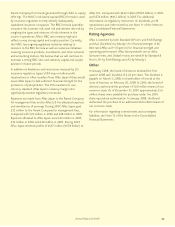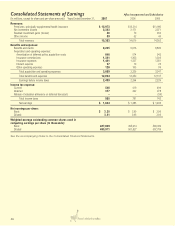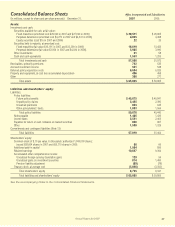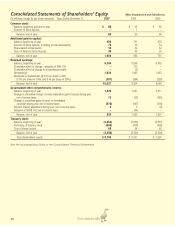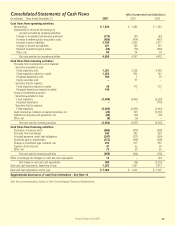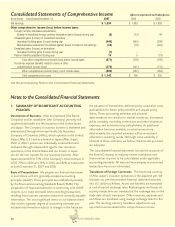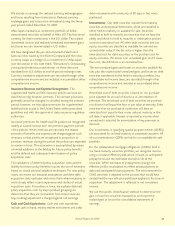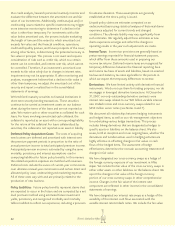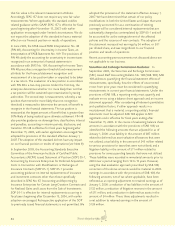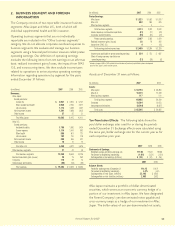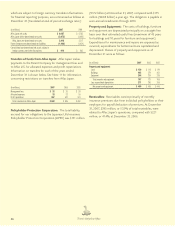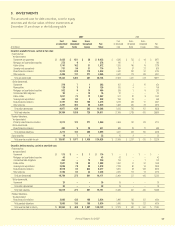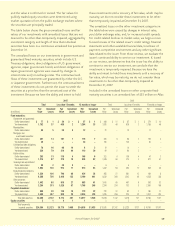Aflac 2007 Annual Report Download - page 55
Download and view the complete annual report
Please find page 55 of the 2007 Aflac annual report below. You can navigate through the pages in the report by either clicking on the pages listed below, or by using the keyword search tool below to find specific information within the annual report.
51
Annual Report for 2007
We include in earnings the realized currency exchange gains
and losses resulting from transactions. Realized currency
exchange gains and losses were immaterial during the three-
year period ended December 31, 2007.
Aflac Japan maintains an investment portfolio of dollar-
denominated securities on behalf of Aflac U.S. The functional
currency for these investments is the U.S. dollar. The related
investment income and realized/unrealized investment gains
and losses are also denominated in U.S. dollars.
We have designated the yen-denominated Uridashi and
Samurai notes issued by the Parent Company and the cross-
currency swaps as a hedge of our investment in Aflac Japan
(see the section in this note titled, “Derivatives”). Outstanding
principal and related accrued interest on these items are
translated into U.S. dollars at end-of-period exchange rates.
Currency translation adjustments are recorded through other
comprehensive income and are included in accumulated other
comprehensive income.
Insurance Revenue and Expense Recognition: The
supplemental health and life insurance policies we issue are
classified as long-duration contracts. The contract provisions
generally cannot be changed or canceled during the contract
period; however, we may adjust premiums for supplemental
health policies issued in the United States within prescribed
guidelines and with the approval of state insurance regulatory
authorities.
Insurance premiums for health and life policies are recognized
ratably as earned income over the premium payment periods
of the policies. When revenues are reported, the related
amounts of benefits and expenses are charged against such
revenues, so that profits are recognized in proportion to
premium revenues during the period the policies are expected
to remain in force. This association is accomplished by means
of annual additions to the liability for future policy benefits
and the deferral and subsequent amortization of policy
acquisition costs.
The calculation of deferred policy acquisition costs and the
liability for future policy benefits requires the use of estimates
based on sound actuarial valuation techniques. For new policy
issues, we review our actuarial assumptions and deferrable
acquisition costs each year and revise them when necessary to
more closely reflect recent experience and studies of actual
acquisition costs. For policies in force, we evaluate deferred
policy acquisition costs by major product groupings to
determine that they are recoverable from future revenues.
Any resulting adjustment is charged against net earnings.
Cash and Cash Equivalents: Cash and cash equivalents
include cash on hand, money market instruments and other
debt instruments with a maturity of 90 days or less when
purchased.
Investments: Our debt securities include fixed-maturity
securities and perpetual debentures, which are classified as
either held to maturity or available for sale. Securities
classified as held to maturity are securities that we have the
ability and intent to hold to maturity or redemption and are
carried at amortized cost. All other debt securities and our
equity securities are classified as available for sale and are
carried at fair value. If the fair value is higher than the
amortized cost for debt securities, or the purchase cost for
equity securities, the excess is an unrealized gain, and if lower
than cost, the difference is an unrealized loss.
The net unrealized gains and losses on securities available for
sale, plus the unamortized unrealized gains and losses on debt
securities transferred to the held-to-maturity portfolio, less
related deferred income taxes, are recorded through other
comprehensive income and included in accumulated other
comprehensive income.
Amortized cost of debt securities is based on our purchase
price adjusted for accrual of discount, or amortization of
premium. The amortized cost of debt securities we purchase
at a discount will equal the face or par value at maturity. Debt
securities that we purchase at a premium will have an
amortized cost equal to face or par value at maturity or the
call date, if applicable. Interest is reported as income when
earned and is adjusted for amortization of any premium or
discount.
Our investments in qualifying special purpose entities (QSPEs)
are accounted for as fixed-maturity or perpetual securities. All
of our investments in QSPEs are held in our available-for-sale
portfolio.
For the collateralized mortgage obligations (CMOs) held in
our fixed-maturity securities portfolio, we recognize income
using a constant effective yield, which is based on anticipated
prepayments and the estimated economic life of the
securities. When estimates of prepayments change, the
effective yield is recalculated to reflect actual payments to
date and anticipated future payments. The net investment in
CMO securities is adjusted to the amount that would have
existed had the new effective yield been applied at the time of
acquisition. This adjustment is reflected in net investment
income.
We use the specific identification method to determine the
gain or loss from securities transactions and report the
realized gain or loss in the consolidated statements of
earnings.






